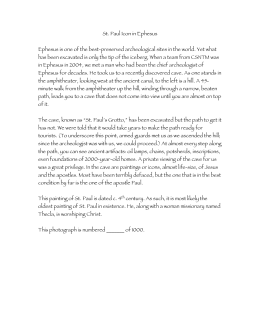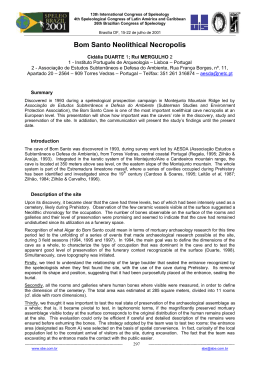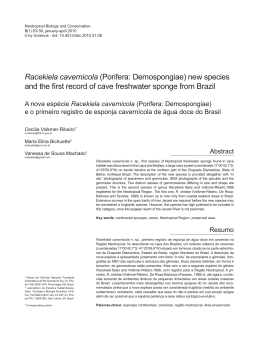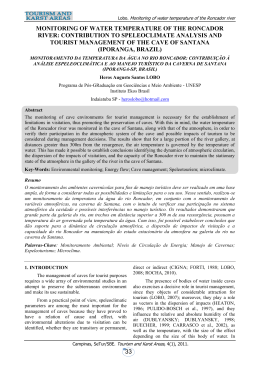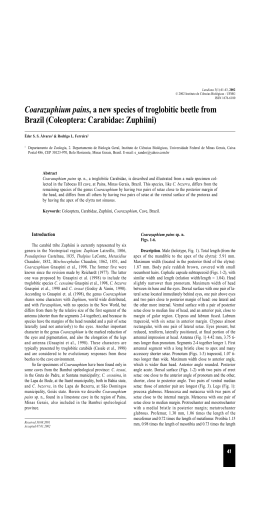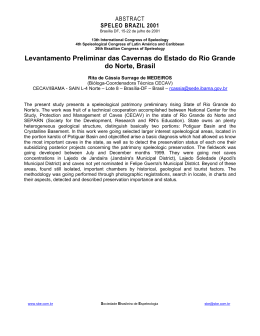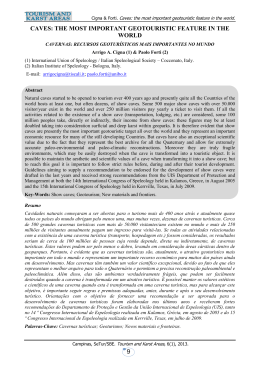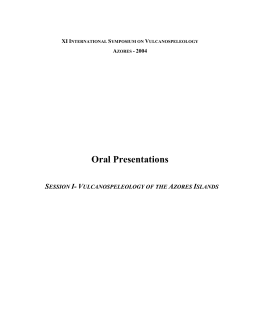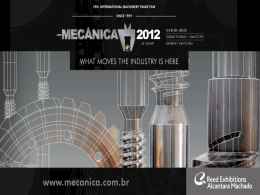Cigna. Show cave development with special references to active caves SHOW CAVE DEVELOPMENT WITH SPECIAL REFERENCES TO ACTIVE CAVES DESENVOLVIMENTO DE CAVERNAS TURÍSTICAS COM ESPECIAL DESTAQUE ÀS CAVERNAS ATIVAS Prof. Arrigo A. CIGNA Past President of the Union Internationale de Spéléologie Cocconato-Asti/Italy - [email protected] Abstract The development of a wild cave into a show cave requires a careful study to evaluate the benefits and risks, by taking into account all pertinent factors such as the access, the synergy and possible conflict with other tourism related activities in the surrounding area, the availability of funds and many other related factors. The conversion should only take place if the results of the studies are positive. Some recently developed plastic materials have the advantage of a very long life, are easy to install and are relatively easy to modify. The development of an active wild cave, i.e. a cave with a watercourse, requires a typical approach, which is different with respect to fossil wild caves. Lampenflora is typical problem of show caves, because the light that is necessary for the visitors supplies enough energy to some plants, mainly algae and mosses, which may grow to the point of defacing and damaging seriously the cave itself. Sustainable development means that the environment meets the needs of the present without compromising the ability of future generations to meet their own needs. To this purpose the compliance with the Management Guidelines, recently adopted by the Union Internationale de Spéléologie, is instrumental for the protection of the cave environment. Key-Words: energy balance; pathways; lighting; management guidelines. Resumo A transformação de uma caverna sem interferências em uma caverna turística requer um estudo cuidadoso para avaliar os benefícios e riscos desta transformação, levando em conta todos os fatores pertinentes ao processo, como a acessibilidade, sinergia e os possíveis conflitos com outras atividades turísticas correlatas em seu entorno, a disponibilidade de recursos e muitos outros fatores relacionados. A transformação deve ser realizada somente se os resultados destes estudos preliminares forem positivos. Sobre as estruturas de visitação, alguns materiais plásticos recentemente desenvolvidos têm a vantagem de apresentar maior vida útil, facilidade de instalação e manutenção relativamente simples. O desenvolvimento de uma caverna ativa em estado natural, por exemplo, uma caverna com um curso d’água em seu interior, requer um escopo específico, o qual é diferente em relação às cavernas fósseis em estado natural. Outro problema típico das cavernas turísticas é a geração de plantas e musgos em seu interior, porque a luz que é necessária para os turistas oferece um aporte energético que permite o seu pleno desenvolvimento, a ponto de causar danos ambientais na caverna. O desenvolvimento sustentável implica que o ambiente pode atender as necessidades do presente, sem comprometer a possibilidade das gerações futuras de prover suas próprias necessidades. Com este propósito, apresentam-se as Diretrizes de Manejo recentemente adotadas pela União Internacional de Espeleologia (UIS), como instrumento para a proteção do ambiente cavernícola. Palavras-Chave: Balanço energético; roteiros de visitação; iluminação; Diretrizes de Gestão. 1. INTRODUCTION 2. PROTECTION OF THE ENVIRONMENT The fundamental principles for the development of a show cave are the protection of the environment, the safety of the visitors and profit. A process of optimisation among these aspects assures the best equilibrium and the reduction of the negative effects to a minimum level. A cave is an environment with little contact with the exterior. Some years ago, Heaton (1986) reviewed the concept of energy levels as applied to caves. He classified caves into one of three categories: high-energy, moderate-energy, and lowenergy levels. High-energy caves experience highenergy events on a regular basis. An example would be those caves that undergo periodic flooding. The strongest forces normally encountered by moderate- Campinas, SeTur/SBE. Tourism and Karst Areas, 4(1), 2011. 7 Cigna. Show cave development with special references to active caves energy caves are orders of magnitude lower than those associated with high-energy caves. The most significant forces may be running water, persistent wind, or even the activities of animals. Low-energy caves are again orders of magnitude smaller. Often in these caves the highest energy event may be a falling drop of water. According to this classification, high-energy passages will be minimally affected by tourist activities because such passages will be rearranged by rock fall or flooding within a year. A river or a subterranean lake plays an important role in maintaining the natural equilibrium because they may absorb, more easily than rock, any further input of energy as it will be discussed later with more details. In a show cave both the visitors and the electric lighting system release energy into the environment. A person who is walking will release nearly as much energy as a 200-watt bulb at a temperature of about 37°C. Therefore the total energy released by hundreds, or thousands, of visitors in a day is not negligible as an absolute amount. The heat released by the electric lighting system has the same order of magnitude (Cigna, 1993). There are different ways to keep the additional energy input into the cave as low as possible. A limit of the number of visitors is given by the so called "visitors' capacity" which is defined as the maximum number of visitors acceptable in a time unit under defined conditions, which does not imply a permanent modification of a relevant parameter. Otherwise, instead of reducing the number of persons, the time they spend in the cave may be reduced. This result may be easily achieved when people enter the cave through one entrance and exit along another passage, instead of returning along the same pathway they entered the cave by. same time, isolate the cave environment from the exterior since an air curtain acts as an invisible door and avoids airflow through it. The protection of the environment of a show cave is fundamental, both from the point of view of avoiding any damage to a non-renewable patrimony, and the conservation of the source of income for the cave management. Therefore such a common interest may have an important role in the implementation of any action aiming to safeguard the cave environment. Visitors also release carbon dioxide as a result of their breathing. Until a few years ago such carbon dioxide was considered a threat to the cave formations since it could have increased the water acidity and, consequently corrosion, instead of the deposition of new formations. Further accurate studies (Bourges et al, 1998) have shown that in many instances the carbon dioxide produced by natural processes (oxidisation of organic matter in the soil above a cave) may introduce, through the water percolating into the cave, amounts very much larger than the carbon dioxide released by visitors. When the percolation water, with a relatively high concentration of carbon dioxide, reaches the cave environment it immediately releases part of this carbon dioxide, which is not in equilibrium with the carbon dioxide in the air. Therefore the chemical reaction moves towards the deposition of calcium carbonate and the formations continue to grow. In general, rather small caves with a high visitor flux, and without any input of natural carbon dioxide, might have formations corroded because the chemical reactions would be reversed when the carbon dioxide in the air dissolves into water, particularly when water vapour condenses on the cave walls. Another form of environmental pollution may occur through the joint contribution of visitors and light. People may release cave spores or seeds of plants into the cave and they may grow in the vicinity of lamps if the light flux is high enough. The result is the so-called "lampenflora" i.e. green plants (generally algae, fern, moss) developing on cave walls or formations close to a light source. Such plants cover the surfaces with a greenish layer, which can become covered by the calcite deposit and no longer be removable. In fact lampenflora can be washed away by bleach or hydrogen peroxide if it is not covered by calcite. Special care must be taken to avoid any damage to the cave fauna. Using high efficiency lamps can reduce the contribution of the electric lighting system. A further reduction can be obtained if the lamps are switched on only when visitors are in the vicinity. Another perturbation of the cave environment is caused by the lint (hair, dry-flaking skin, dust from shoes and material from clothing) left by visitors. In caves visited by a large number of people the accumulation of lint becomes a real problem to be solved by careful removal. In fact it would cause deterioration of formations and reduce their pristine white beauty to a blackened mess. The growth of lampenflora can be avoided by the employment of light sources with a very low emission of light that does not encourage the Lint released into a cave might be reduced by means of air curtains at the entrance. Such a solution would “wash” people entering the cave and, at the Campinas, SeTur/SBE. Tourism and Karst Areas, 4(1), 2011. 8 Cigna. Show cave development with special references to active caves chlorophyllian process and low light flux at the rock surface. 3. SAFETY OF THE VISITORS As it has already been pointed out in the previous paragraphs the physical and chemical equilibriums of the environment should not be modified outside the range of the natural variations. At the same time, any source of harm to the visitors must be avoided. This means that the pathways must be strong enough to withstand very high humidity and, sometimes, also floods. In the past, wooden structures were often used, but they had to be replaced frequently. Today, there are some self perceived “green” enthusiasts who want to still use wood because this material is natural. Nevertheless the rather short life of a wooden structure in the cave environment implies an additional cost, which is not justified. On the contrary the rotten wood provides large amounts of food modifying the equilibrium of the cave life. There is only one particular situation when wooden structures are to be preferred: and that is in the ice caves. In fact wood surface is less slippery than any other material and the low temperature avoids its decay. Again the “green” enthusiasts have emphasised the criterion to use only structures, which can be easily decommissioned, once they are no longer needed. Such an argument is substantially wrong because, once it is no longer viable to operate a show cave, no one will spend any money to take any structure out of the cave even if they are relatively easy to decommission. Recently plastic structures have been used in caves to build pathways. Presently the best material available on the market is a fiberglass reinforced plastic. Its key product features are that it is lightweight, corrosion resistant, non-conductive, low maintenance, slip resistant, fire retardant, etc. In addition this material has a high strength-to-weight ratio with one-third the weight of steel, allowing easy installation, with no heavy equipment, and less manpower. In fact simple tools easily work such materials and the different parts of the structure are assembled with stainless steel bolts. Another interesting advantage is the possibility of modifying any pathway very easily. On the other hand, other mixtures, e.g. of plastics and sawdust, must never be used because they are easily degraded by mould and their mechanical characteristics are quite poor. An active cave is obviously subject to floods. Recently the climate changes have not really modified the annual amount of rainwater but its distribution is less uniform. For this reason periods of heavy precipitation are followed by relatively dry periods. Therefore since the size of the cave passages has not changed, the chance of important floods has increased and the water flow inside a cave might reach levels higher than in the past. To avoid a collapse of the pathways, these structures must be designed in order to withstand not only a vertical charge due to the visitors but also a horizontal force due to an exceptional water flow. It is obvious that in general the tourists will not be allowed inside a cave during heavy storms with the risk of floods, nevertheless these floods should not damage the pathways seriously. In the meantime, it is preferable to use a material that is compatible with the cave environment and will not release pollutants in the long run. At present, these materials are concrete, stainless steel and plastic. In any case it is possible that, sometimes, rocks displaced by the water flow may damage some parts of the pathways. The structure obtained with plastics, as reported before, are the most suitable to replace rather easily the damaged elements at low cost and in a short time, by reducing to a minimum the economical consequences. Concrete in itself is economical but its use in a cave may become rather expensive when it must be carried along difficult passages where the use of mechanical aids is not allowed. However, any change in the future would make it difficult to disassemble the pathways and dispose of the waste. 4. PROFIT Before starting any procedure to develop a wild cave into a show cave, a detailed study of the whole situation is required. Nearly twenty years ago, two great experts of cave management, Russell and Jeanne Gurnee (1981), wrote: "The successful development and operation of a tourist cave depends on a combination of factors, including: 1) Scientific investigation 2) Art 3) Technology 4) Management” Handrails made from stainless steel are also a convenient solution, particularly when they are also used as pipes to provide fresh water in different parts of the cave to wash the pathways. In fact, this higher cost of stainless steel is justified by a lack of any maintenance after many years of operation. Campinas, SeTur/SBE. Tourism and Karst Areas, 4(1), 2011. 9 Cigna. Show cave development with special references to active caves Scientific study is recommended at the beginning, as the first phase, in order to determine which hydrologic and geologic factors may have an influence on the development. Art is necessary both in determining the routeing of trails and selecting particular cave scenes to feature, and in lighting which is in itself a combination of both art and the next factor, technology. The technology necessary to control water and other natural forces within the cave and to design suitable trails again combines with art to create a tasteful and agreeable cave tour. Management continues from the time the first plans are laid, through the developed or operational phase. The four factors listed above apply both to the development of private caves and public or government lands. Often, because of limited financial resources of a private owner, one or more of these factors is not considered, and poor development and lack of financial success may result. Failure of a cave to succeed, either through the development phase or after, when the cave is open to the public, can lead to an unprotected area which has been advertised and known to the public that can be subsequently subject to vandalism. In order to ensure that a cave has the highest chance of success as a tourist endeavour, a comprehensive study and evaluation should be made before any physical work is commenced. A cave study provides a "blueprint" which investors, technical people, workmen, exhibitors and administrators can follow to bring about a successful cave operation. The study plan is coordinated by management in order to develop a plan for the best display of the cave. With a detailed study and cost prospectus, at the time the development is originally proposed, a cave can be successfully developed less expensively, more effectively and in less time. Technological advances in the past fifty years in lighting, communications, transportation, marketing techniques and almost every phase of cave development, make it important to find the most efficient ways to complete the project. Every cave must be looked at from the position of the businessman, artist, engineer, speleologist and conservationist. The modification of a natural cave to permit easy visitation of the public requires all of these viewpoints. Balance among these views, through decisions made before beginning the venture, will assure a sound development. Speleological associations, which bring together those caves being considered for tourism, can be of great service not only to the group developing a cave, but also in preserving the cave as nearly as possible to its natural state”. It would be really rather difficult to have a better description of the procedure to adopt for the development of a tourist cave. In addition to an Environmental Impact Assessment, the procedures suggested in the planning phase commonly include those that can quantify certain parameters (topographical, social and economic) used to predict tourist flows. Some of these methodological procedures, well known and successfully applied in the geographic-economic field, tend not to be employed in the development of show caves because of some lack of knowledge. The rather widespread feeling among speleologists, and people in general, that a cave is "lost" to science when it is developed as a tourist attraction, is not at all supported by the important scientific results obtained from many show caves. Sometimes the borderline between use and abuse may be difficult to define; nevertheless a careful development continuously monitored may be the most efficient way to protect a cave. It is evident that the economy of a region around a show-cave-to-be can be radically modified by the cave development. Therefore strenuous opposition to any tourist visitation appears to be rather unfair towards the local people, particularly when a suitable compromise between strict conservation and a sound development can be found. But in any case, as it was previously reported, a cave development cannot be accepted if it is not supported by appropriate preliminary research. A recent evaluation of the number of show cave visitors all around the world (Cigna & Burri, 2000), based on data obtained for about 20% of all show caves, estimate a global number of more than 150 million visitors per year. By assuming a budget per person as reported in Table 1 the total amount of money spent to visit the show caves is around 3 billion US $ (2008). The number of the local people directly involved in the show cave business (management and local services) can be estimated to be up to several hundred per cave, i.e. some hundreds of thousands of individuals in the world. By taking into account that there are several hundred other people working indirectly to each person directly connected with a show cave (Forti & Cigna, 1989), a gross global figure of about 100 million people receive income from the show cave business. Therefore, it can be roughly assumed that for each tourist visiting a show cave there is about one other person directly or indirectly connected who is earning income from the visit. Campinas, SeTur/SBE. Tourism and Karst Areas, 4(1), 2011. 10 Cigna. Show cave development with special references to active caves In addition to show caves, the existence of karst parks, which include a cave within their boundaries, must also be considered. As reported by Halliday (1981) the number of visitors to the top three karst national parks in USA (Mammoth Cave, Carlsbad Caverns and Wind Cave) amounted to about 2,500,000 tourists each year. Therefore karst parks give a further increase to the number of people involved in the whole "karst" business. Table 1 - Rough estimation of the annual direct and local budget of a show cave per each visitor (in US $, 2008). Source US$ Direct income 6.5 Other local income: Souvenirs & snacks 2.0 Meals 6.5 Transportation 2.5 Travel agency 2.5 TOTAL 20.0 will start. On the other hand, if such a set is not negative there is a chance that stagnation last for a longer time without a decline. But, if the management is more careful and diligent, then it can take some initiatives. Such initiatives may be simple actions, which could be just enough able to counteract the stagnation and start again a further growth of the number of visitors. If, on the contrary, such initiatives are much more effective, a true rejuvenation can be obtained and the growth of the number of visitors could be the sign of a new era in the life of the cave. Such a change is typical of the development of a new attractive to be developed either inside the cave (new pathway, lighting, “son et lumière”, etc.) or outside (park area, tourist attractions, etc.). 5. THE MANAGEMENT OF SHOW CAVES There are many other human activities that involve a larger number of people; nevertheless the figures reported above are not negligible, and give an indication of the role that show caves play in the global economy. The “destination life cycle” term was first mentioned in Butler’s model (1980). Such a concept led to the development of a model very useful to describe the stages of evolution of a tourist attraction (Swarbrooke, 1999) as reported in Fig. 1. Once the critical range of elements of capacity is reached, i.e. the level of stagnation, there are four possibilities of evolution. If the management does not act, the evolution may be comprised between decline and stabilisation according to other factors independent from the management itself. If a whole set of socioeconomic factors is negative a decline In 1997 the IUCN World Commission on Protected Areas issued a booklet (Watson et al., 1997) with guidelines for cave and karst protection, taking care of caves in general, i.e. wild caves. The principia included in this publication provided a good basis but it was deemed necessary to have guidelines directed particularly to show caves The concept of establishing guidelines to be used as general parameters for good show cave management, originated during informal discussions between members of the International Show Caves Association at the time of the inaugural meeting of ISCA in Genga, Italy, in November 1990. These discussions continued over time and were first drafted for consideration at an ISCA meeting held on 17th September 2004 during the 30 th Anniversary of the opening of Frasassi Cave, in Italy, to the public (Cigna, 2005). Fig. 1 - Tourist area cycle of evolution (Swarbrooke, 1999) Campinas, SeTur/SBE. Tourism and Karst Areas, 4(1), 2011. 11 Cigna. Show cave development with special references to active caves The idea of creating guidelines, received strong recommendations from the UIS Department of Protection and Management at the 14 th International Congress of Speleology held in Kalamos, Greece, in August 2005 (Cigna, 2008). These management guidelines are the result of wide cooperation between the International Show Caves Association (ISCA), the Union Internationale de Spéléologie (UIS) and the International Union for Conservation of Nature and Natural Resources (IUCN). The intention was to create commonly accepted guidelines that all show caves managers can work towards, taking into account both the protection of the environment and socio-economical constraints. Many recommendations and suggestions have been received in the course of nearly twenty years, and therefore the document reported here can be considered as the result of an active cooperation among specialists involved in this matter (Cigna, 2009; 2010). Since the General Assembly of ISCA in Liptovsky Mikulas, Slovakia, October 2010, has not approved such guidelines for reasons outside the scientific domain, they are now issued as a UIS document. UIS Management Guidelines for Show Cave 1 DEVELOPMENT OF A WILD CAVE INTO A SHOW CAVE The development of a show cave can be seen as a positive financial benefit to not only itself, but also the area surrounding the cave. The pursuit of these anticipated benefits can sometimes cause pressure to be applied to hasten the development of the cave. Before a proposal to develop a wild cave into a show cave becomes a physical project, it is necessary to carry out a careful and detailed study to evaluate the benefits and risks, by taking into account all pertinent factors such as the access, the synergy and possible conflict with other tourism related activities in the surrounding area, the availability of funds and many other related factors. The conversion should only take place if the results of the studies are positive. A wild cave that is developed into a show cave, and is subsequently abandoned, will inevitably become unprotected and be subject to vandalism in a very short time. A well managed show cave assures the protection of the cave itself, is a source of income for the local economy and also may contribute to a number of scientific researches. 1-1 A careful study of the suitability of the cave for development, taking into account all factors influencing it, must be carried out, and must be carefully evaluated, before physical development work commences. 2 ACCESS AND PATHWAYS WITHIN THE CAVE In many caves it has been found to be desirable to provide an easier access into the cave for visitors through a tunnel, or a new entrance, excavated into the cave. Such an artificial entrance could change the air circulation in the cave causing a disruption of the ecosystem. To avoid this, an air lock should be installed in any new entrance into a cave. On the other hand it must be mentioned that in some very exceptional cases a change in the air circulation could revitalize the growth of formations. A decision not to install an air lock must be only taken after a special study. 2-1 Any new access into a cave must be fitted with an efficient air lock system, such as a double set of doors, to avoid creating changes in the air circulation within the cave. Caves are natural databases, wherein an incredible amount of information about the characteristics of the environment, and the climate of the cave, are stored. Therefore any intervention in the cave must be carried out with great care to avoid the destruction of these natural databases. 2-2 As much as possible, any development work carried out inside a cave should avoid disturbing the structure, the deposits, and the formations of the cave. When a wild cave is developed into a show cave, pathways and other features must be installed. This invariably requires materials to be brought into the cave. These materials should have the least possible impact on both the aesthetics of the cave and its underground environment. Concrete is generally the closest substance to the rock that the cave is formed in, but once concrete is cast it is extremely expensive and difficult to modify or decommission. Stainless steel has the distinct advantage that it lasts for a long time and requires little, to no, maintenance but it is expensive and requires special techniques to assemble and install. Some recently developed plastic materials have the advantage of a very long life, are easy to install and are relatively easy to modify. 2-3 Only materials that are compatible with the cave, and have the least impact on the cave, should be used in a cave. Cement, concrete, stainless steel and Campinas, SeTur/SBE. Tourism and Karst Areas, 4(1), 2011. 12 Cigna. Show cave development with special references to active caves plastics that do not emit volatile organic chemical are examples of such materials. The environment of a cave is usually isolated from the outside and therefore the introduction of energy from the outside will change the equilibrium balance of the cave. Such changes can be caused by the release of heat from the lighting system and the visitors and also by the decay of organic material brought into the cave, which introduces other substances into the food chain of the cave ecosystem. In ice caves, the environmental characteristics are compatible with wood, which is frequently used for the construction of pathways, as it is not slippery. 3 LIGHTING The energy balance of a cave should not be modified beyond its natural variations. Electric lighting releases both light and heat inside the cave. Therefore high efficiency lamps are preferred. Discharge lamps are efficient, as most of the energy is transformed into light, but only cold cathode lamps can be frequently switched on and off without inconvenience. Light-emitting diode (LED) lighting is also very promising. As far as possible, the electric network of a cave should be divided into zones to enable only the parts that visitors are in to be lit. Where possible a non-interruptible power supply should be provided to avoid problems for the visitors in the event of a failure of an external power supply. Local code requirements may be applicable and these may permit battery lamps or a network of LEDs or similar devices. 3-1 Electric lighting should be provided in safe, well-balanced networks. The power supply should preferably be noninterruptible. Adequate emergency lighting should be available in the event of a power outage. Lampenflora is a fairly common consequence of the introduction of an artificial light supply into a cave. Many kinds of algae, and other superior plants, may develop as a result of the introduction of artificial light. An important method to avoid the growth of green plant life is to use lamps that do not release a light spectrum that can be absorbed by chlorophyll. 3-2 Lighting should have an emission spectrum with the lowest contribution to the absorption spectrum of chlorophyll (around 440 nm and around 650 nm) to minimize lampenflora. Another way to prevent the growth of lampenflora is the reduction of the energy reaching any surface where the plants may live. The safe distance between the lamp and the cave surface depends on the intensity of the lamp. As a rough indication, a distance of one meter should be safe. Special care should also be paid to avoid heating the formations and any rock paintings that may exist. 3-3 Lighting sources should be installed at a distance from any component of the cave to prevent the growth of lampenflora and damaging the formations and any rock paintings. The lighting system should be installed in such a way that only the portions of the cave occupied by visitors are switched on, leaving the lighting in the portions of the cave that are not occupied switched off. This is important from the aspects of reducing the heating of the cave environment and preventing the growth of lampenflora, as well as decreasing the amount of energy required and its financial cost. 3-4 Lighting should be installed to illuminate only the portions of the cave that are occupied by visitors. The lighting system should be installed in such a way that only the portions of the cave occupied by visitors are switched on, leaving the lighting in the portions of the cave that are not occupied switched off. This is important from the aspects of reducing the heating of the cave environment and preventing the growth of lampenflora, as well as decreasing the amount of energy required and its financial cost. 4 FREQUENCY OF VISITS NUMBER OF VISITORS The energy balance of a cave environment can be modified by the release of heat by visitors. A human being, moving in a cave, releases about 150 watts – approximately the same as a good incandescent lamp. Consequently, there is also a limit on the number of visitors that can be brought into a cave without causing an irreversible effect on the climate of the cave. 4-1 A cave visitor capacity, per a defined time period, should be determined and this capacity should not be exceeded. Visitor capacity is defined as the number of visitors to a given cave over a given time period, which does not permanently change the environmental parameters beyond their natural fluctuation range. A continuous tour, utilizing an entrance and another exit, can reduce the time that visitors spend Campinas, SeTur/SBE. Tourism and Karst Areas, 4(1), 2011. 13 AND Cigna. Show cave development with special references to active caves in a cave, compared to the use of a single entrance/exit. In addition to the normal tours for visitors, many show caves have special activities, sometimes called “adventure tours”, where visitors are provided with speleological equipment for use in wild sections of the cave. If such a practice is not properly planned, it may cause serious damage to the cave. 4-2 When visits to wild parts of a cave are arranged, they must be carefully planned. In addition to providing the participants with the necessary speleological safety equipment, the visitors must always be guided by a guide with good experience in wild caves. The pathway, where visitors are to travel along, must be clearly defined, for example with red and white tape, and the visitors should not be allowed to walk beyond this pathway. Special care must be taken to avoid any damage to the cave environment, and the parts beyond the pathway must be maintained in a clean condition. 5 PRESERVATION OF THE SURFACE ECOSYSTEM WHEN DEVELOPING BUILDINGS, PARKING, REMOVAL OF SURFACE VEGETATION AND WASTE RECOVERY It is important that the siting of the above ground facilities, such as the buildings, parking and waste recovery, be well planned. There is a natural tendency to try and place these development features as close as possible to the cave entrance. Sometimes these features are built over the cave itself, or relevant parts of it. The hydrogeology above the cave must not be modified by any intervention such as the watertight surface of a parking area. Any change in the rainwater seepage into a cave can have a negative influence on the cave and the growth of its formations. Care should be exercised also when making any change to the land above the cave, including the removal of the vegetation and disturbance of the soils above the bedrock. 5-1 Any siting of buildings, parking areas, and any other intervention directly above the cave, must be avoided in order to keep the natural seepage of rainwater from the surface in its original condition. 6 MONITORING After the environmental impact evaluation of the development, including any other study of the cave environment, it is necessary to monitor the relevant parameters to ensure that there is no deviation outside acceptable limits. Show caves should maintain a monitoring network of the cave environment to ensure that it remains within acceptable limits. 6-1 Monitoring of the cave climate should be undertaken. The air temperature, carbon dioxide, humidity, radon (if its concentration is close to or above the level prescribed by the law) and water temperature (if applicable) should be monitored. Airflow in and out of the cave could also be monitored. When selecting scientists to undertake studies in a cave, it is very important that only scientists who have good experience with cave environments be engaged for cave related matters. Many, otherwise competent scientists, may not be fully aware of cave environments. If incorrect advice is given to the cave management, then this could result in endangerment of the cave environment. Cave science is a highly specialized field. 6-2 Specialized cave scientists should be consulted when there is a situation that warrants research in a cave. 7 CAVE MANAGERS The managers of a show cave must never forget that the cave itself is “the golden goose” and that it must be preserved with great care. It is necessary that persons involved in the management of a show cave receive a suitable education, not only in the economic management of a show cave, but also about the environmental issues concerning the protection of the environment at large. 7-1 Cave managers should be competent in both the management of the economics of the show cave and its environmental protection. 8 TRAINING OF THE GUIDES The guides in a show cave have a very important role, as they are the “connection” between the cave and the visitor. Unfortunately, in many instances the guides have not been trained properly and, not withstanding that they are doing their best, the overall result will not be very good. It is very important that the guides receive proper instructions about the environmental aspects of the cave as well as dealing with the public. It is important that Campinas, SeTur/SBE. Tourism and Karst Areas, 4(1), 2011. 14 Cigna. Show cave development with special references to active caves guides are skilled in tactfully avoiding entering into discussions, which can have a detrimental effect on the overall tour. The guides are the guardians of the cave and they must be ready to stop any misbehaviour by the visitors, which could endanger the cave environment. 8-1 Cave guides should be trained to correctly inform the visitors about the cave and its environment. 6. CONCLUSION Following the cycle of Fig. 1, after the “stagnation” step there are four possible evolutions: decline, stabilization, reduced growth and rejuvenation. The first one, i.e. decline is the consequence of an outside factor (crisis, decrease of interest, etc.), which is not counterbalanced by any action of the cave management. The stabilization may happen if the influence of the outside factors is not too strong. The reduced growth may develop if the outside factors are minimal or, at least, the cave management adopts some actions to add some improvement if the cave development. The most interesting case is the rejuvenation, i.e. an important addition of new sources of interest for the potential visitors. Such a result may be achieved both inside the cave, after an important change of its structures (new passages developed for visitors, new lighting system, etc.) or the development of other source of interest outside the cave (natural park, monuments, tourist attractions, etc.). Examples of such interventions in France are reported by Gauchon & Biot (2010). Obviously the last case is the most effective and should always be taken into account by a cave manager in order to keep alive the tourists’ interest into the cave and its environment. In conclusion the whole show cave "industry" must be constantly and carefully changing to adapt to the shifts that are brought to us all by our rapidly changing world. There are challenges that we must all rise up and meet. Finally, the UIS Management Guidelines for Show Cave, reported above, are a strong recommendation to be adopted by show cave managers in order to assure the protection of the cave environment, the safety of the visitors as well a sustainable development, which means that the environment meets the needs of the present without compromising the ability of future generations to meet their own needs. REFERENCES BOURGES F., D'HULTS D AND MANGIN A., Étude de l'Aven d'Orgnac. Rapport final, Lab. Souterrain de Moulis -C.N.R.S.- Géologie Environnement Conseil, p.1-84, 1998. BUTLER R.W. The Concept of a Tourist Area Life Cycle of Evolution. Canadian Geographer, 24, p. 5-12, 1980. CIGNA A.A. Environmental management of tourist caves. The examples of Grotta di Castellana and Grotta Grande del Vento, Italy. Environmental Geology, v.21, n.3, p. 173-180, 1993. Also as: Report ENEA RT-AMB-93-09. CIGNA A.A. Alcuni criteri di base per lo sviluppo di grotte turistiche: la "Charta di Frasassi". Atti Incontro Internazionale di Speleologia Frasassi 2004. Senigallia: 73-76, 2005 CIGNA A.A., Some basic principles for the devemopment of show caves: the Frasassi Charta. Proc. 14th Int. Congr. Speleology, Kalamos, Greece, 1: 364-365, 2008. CIGNA A.A., 2009 – The ISCA Management Guidelines for show caves. Proceedings 15th Int. Congr. of Speleology, Kerrville, Texas, USA, 2:1085-1088, 2009. CIGNA A.A., 2011 - Draft management guidelines for show caves. ACKMA Journal, No. 80, September 2010: 28-30. CIGNA A.A. & BURRI E. Development, management and economy of show caves. Int. J. Speleol., v. 29 B, n.1-4, p.1-27, 2000 Campinas, SeTur/SBE. Tourism and Karst Areas, 4(1), 2011. 15 Cigna. Show cave development with special references to active caves CIGNA A.A. & SUMMERS D. The International Commission on Sustainable Development in Show Caves. Proceedings 15th Int. Congr. of Speleology, Kerrville, Texas, USA, v. 2, p.1089-1091, 2009, FORTI P. & CIGNA A.A. Cave tourism in Italy: an overview. Cave Tourism, Proc. Int. Symp. 17Oth Anniv. Postojnska Jama, Postojna, Nov. 10-12, 1988. Centre Scient. Res. SAZU & Postojnska Jama Tourist and Hotel Organiz., p. 46-53, 1989. GAUCHON C. & BIOT V. Valorisation touristique du karst: grottes amenagées et paysages extérieurs. In: AUDRA PH. (Dir.) Grottes et karst de France. Karstologie Mémoires, n. 19, 2010, p. 114-115. GURNEE R., GURNEE J. The study report on the development of Harrison Cave, Barbados, West Indies. Atti Conv. Int. Grotte Turistiche, Borgio Verezzi 20-21 Marzo 1981; Grotte d'Italia, s.4, v.10, p.101-107, 1981. HALLIDAY W.R. Karstic national parks: international economic and cultural significance. Proc. Int. Symp. Utilization of Karst Areas, Trieste March 29-30, 1980. Ist. Geol. e Paleont. - Commissione Grotte Boegan, CAI Trieste, p.135-144, 1981. HEATON T. Caves. A Tremendous Range in Energy Environments on Earth. National Speleological Society News, August, p. 301-304, 1986. SWARBROOKE, J. Sustainable tourism management. Wallingford, UK, CABI, 1999. WATSONJ., HAMILTON-SMITH E., GILLIESON D. & KIERNAN K. (Eds.) Guidelines fo Cave and Karst Protection . IUCN, Gland, Switzerland and Cambridge, UK, p. 1-53, 1997. Fluxo editorial: Recebido em: 11.01.2011 Corrigido em: 18.03.2011 Aprovado em: 19.04.2011 TOURISM AND KARST AREAS (formally/formalmente: Pesquisas em Turismo e Paisagens Cársticas) Brazilian Society of Speleology / Sociedade Brasileira de Espeleologia (SBE) www.cavernas.org.br/turismo.asp Campinas, SeTur/SBE. Tourism and Karst Areas, 4(1), 2011. 16
Download
